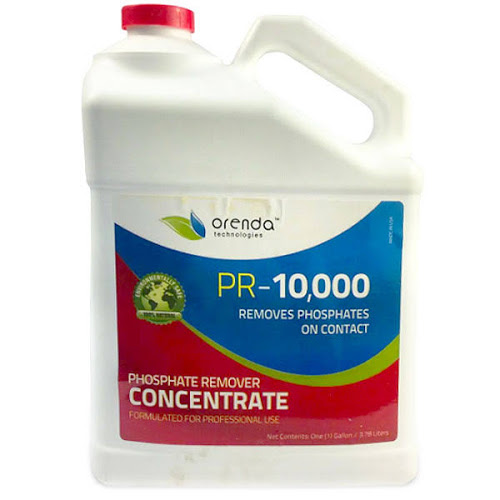|
What are Phosphates? Phosphates are chemical compounds that contain phosphorus. In addition to phosphorus, phosphates contain oxygen and sometimes hydrogen. Phosphates are a biological building block that is constantly being introduced to your pool water and nourishing algae. Phosphorus is a primary food source for aquatic plants including all types of algae. Phosphate compounds are broken down into their simplest form, orthophosphates, in one of the following three ways: Oxidation (converting compounds into oxides) Hydrolysis (decomposition by water, and Enzymatic digestion. Regardless of how it happens, if phosphates are allowed to remain present in pool or spa water they will be reduced to orthophosphates, which are the only form of phosphates that algae can digest. Orthophosphate levels should remain below 100-125 ppb (parts per billion). Once levels exceed 200 ppb, algae becomes increasingly resistant to sanitizers, including chlorine shock. Excessive levels of orthophosphate, such as 1,000 ppb or more, should be brought under control with a phosphate remover such as Natural Chemistry Phos-free or Bio-dex Phosphate remover plus. Phosphates are the most overlooked chemical test performed on a pool. Most 5 and 7 point dip test strips do not test for phosphate. Many pool owners don’t know about phosphates until it’s too late. Phosphate levels should be measured at least once a month. Sources of Phosphates The largest source of phosphates entering your pool come from the public water systems. Municipal water treatment plants commonly add phosphates to the drinking water as a corrosion inhibitor to prevent the leaching of lead and copper from pipes and fixtures. Inorganic phosphates (e.g., phosphoric acid, zinc phosphate, and sodium phosphate) are added to the water to create orthophosphate, which forms a protective coating of insoluble mineral scale on the inside of service lines and household plumbing. The coating serves as a liner that keeps corrosion elements in water from dissolving some of the metal in the drinking water. As a result, lead and copper levels in the water will remain low. The key to ensuring that orthophosphate reduces lead and copper levels, is for Public water systems to maintain proper orthophosphate levels. The health effects of drinking water with phosphates are not known. The Food and Drug Administration (FDA) has issued a report on the toxicology of inorganic phosphates as food ingredients. The FDA considers phosphates as a food additive to be "generally recognized as safe." The challenge with phosphates is that they are constantly being introduced into your swimming pool water. They are found in lawn and garden fertilizers, decaying vegetation, municipal water, cosmetic items on bathers, and even other pool chemicals. This means a fresh batch of phosphates enter your water when any of the following occur:
How to determine if you have a high phosphate level Use phosphate specific test strips. These strips are highly accurate and measure orthophosphate levels in 10 seconds. They have the widest testing range available on the market, at 0 – 6,000 ppb. (parts per billion). Water tests should be conducted weekly during peak swimming season and monthly during the off-season. The best part – this test kit only costs about $15.00 which is money you will save on shock and excess sanitizers to clear up algae blooms caused by high phosphate levels.  Why are phosphates bad Sixty percent of pool owners experience two full algae blooms every season. So, what causes these blooms and how can we prevent them. Phosphates are algae food they are needed to complete the photosynthesis process and promote algae blooms, once algae starts to bloom the available chlorine in your pool is consumed at an alarming rate as it tries to fight the algae. With no available chlorine to sanitize your pool it becomes helpless and starts to turn green and turbid specially in the warm summer months, Algae loves to thrive in warm dark waters. Phosphates plus low chlorine equals disaster.  How do you get rid of Phosphates There is no amount of chlorine that will kill phosphates. Special chemicals are needed to trap and reduce the level of the phosphates from swimming pool water. Phosphates can never be completely removed, but can be managed at a low level. This process typically takes two service visits to complete in full. Our first visit we brush down all walls and remove all debris from the baskets. We need to insure that there is proper flow with your equipment in order for the treatment to work correctly. If your filter is in need of cleaning we will recommend doing this before we start the treatment. We then add our chemicals to the water of your pool. The amount of chemicals that we use is determined by the amount of water the pool carries. These chemicals need to circulate in your system for the next 24 hours. Pool Phosphate Removal Tips:
How to prevent Phosphates from building up to a dangerous level
It is important to remember that phosphate removal is a preventative measure, if you have active algae present in the pool, treat it with chlorine shock and algaecide first, then follow up with a phosphate remover to prevent reoccurrence. As algae die, they release phosphates in to the water, making it more likely that algae will return, creating a vicious cycle of expensive to treat algae bloom after algae bloom.
|
AuthorWrite something about yourself. No need to be fancy, just an overview. Archives
August 2018
Categories
All
|
